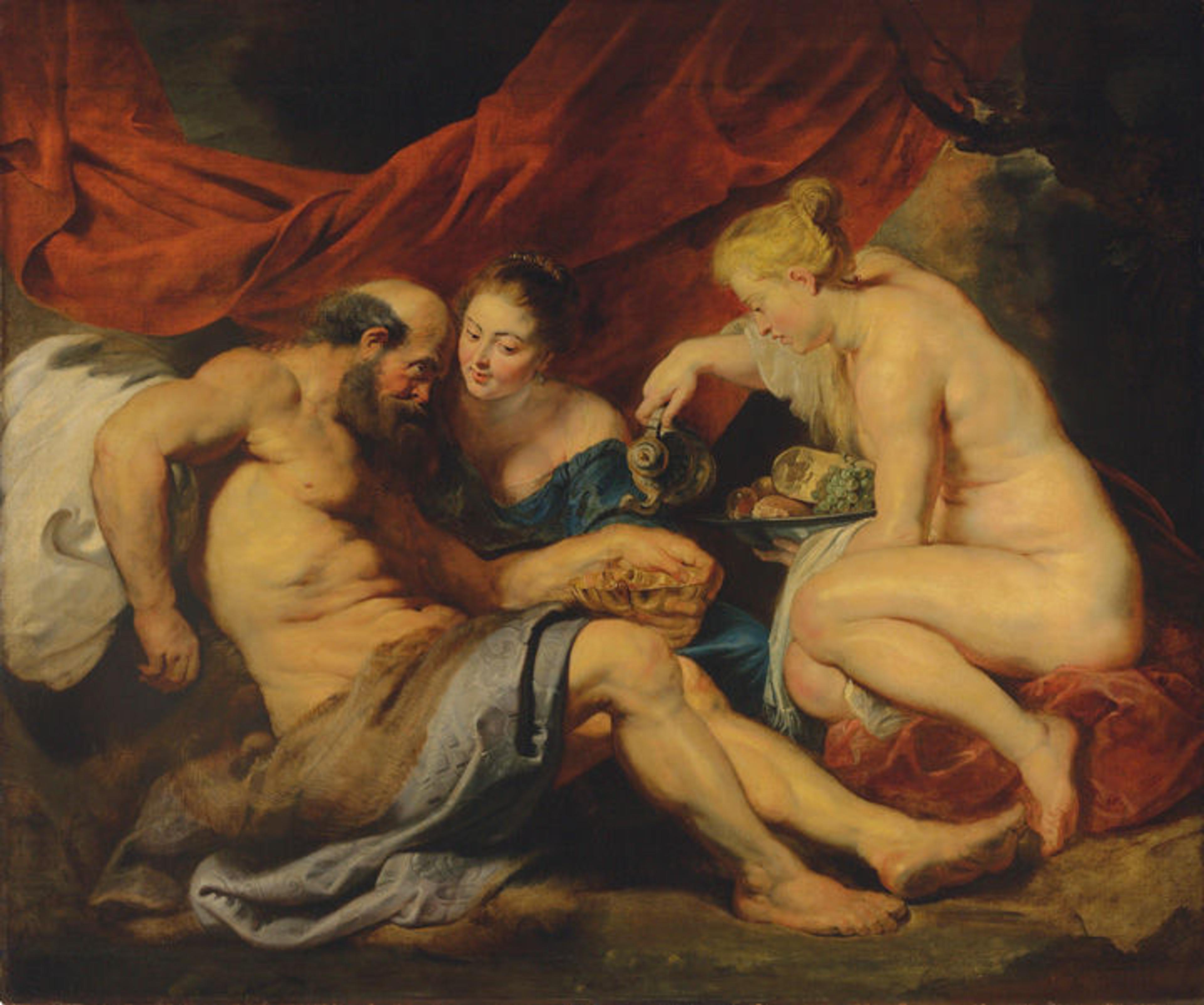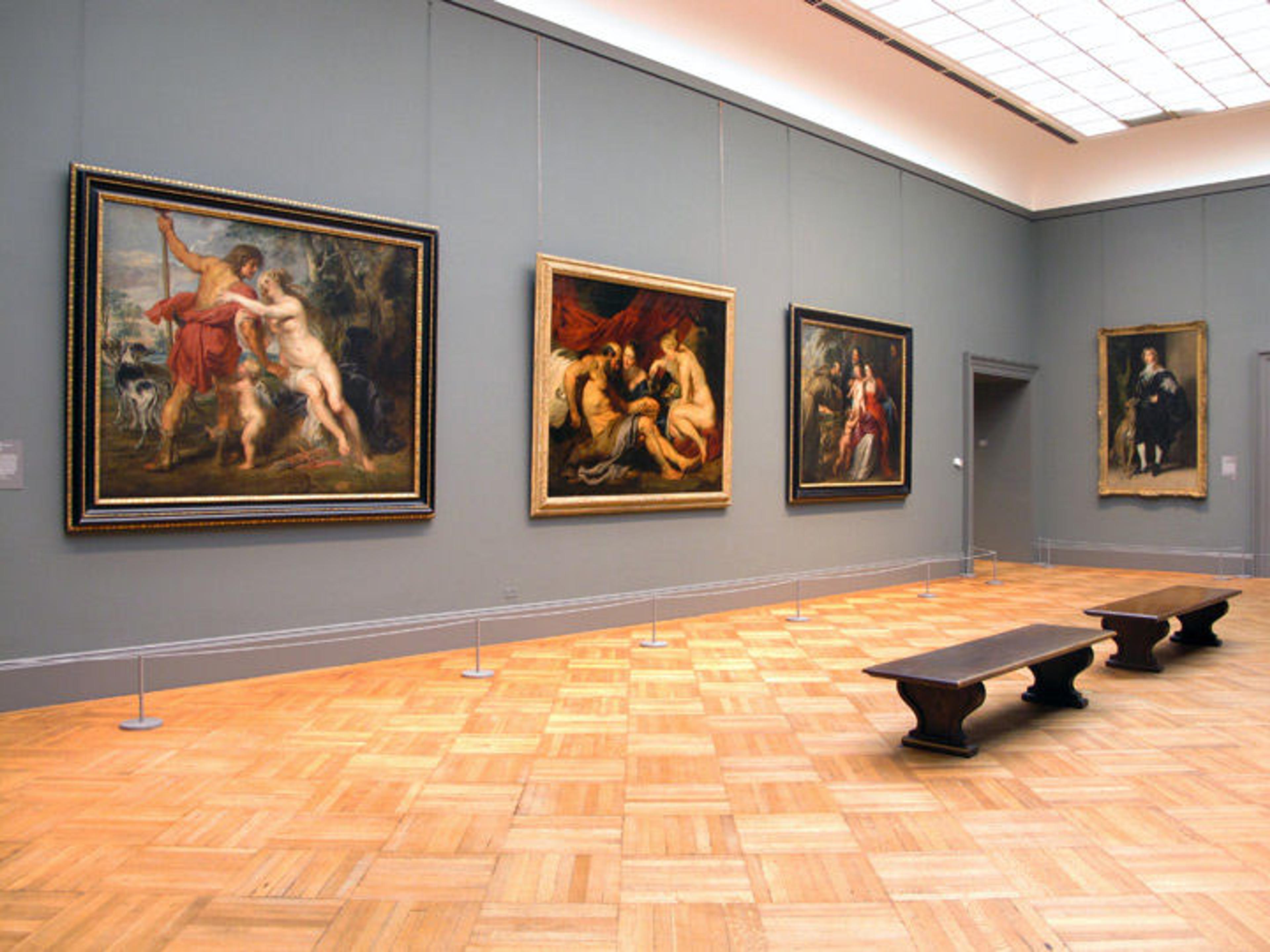
Peter Paul Rubens (Flemish, 1577–1640). Lot and His Daughters, ca. 1613–14. Oil on canvas, 74 x 88 1/2 in. (190 x 225 cm). From the collection of an anonymous charitable foundation
«The tale of Lot and his daughters is one of the most shocking episodes in the Bible. As recounted in Genesis 19, the story begins with the visit of two angels to the wicked city of Sodom. The angels, disguised as travelers, find hospitality at Lot's home, but an angry mob soon surrounds the house demanding that Lot surrender the angels to their lust. Insisting on the sacred rules of hospitality, Lot proposes his own daughters in place of the angels. The Sodomites reject Lot's shocking offer and attempt to storm his house, only to be struck blind by the angels. The heavenly visitors then inform Lot of the city's impending destruction and counsel him to flee with his wife and daughters.»
On the road out of the city, Lot's wife disregards the angels' directives not to look back toward Sodom and is promptly turned into a pillar of salt. The diminished family of three takes refuge in a cave above the town of Zoar, where the story reaches its climax. Convinced that no other men have survived to give them children, Lot's daughters conspire to get their father drunk and become pregnant by him in turn.
This disturbing episode enjoyed a long and surprising afterlife in the art of Northern Europe. While theologians might argue that neither Lot nor his daughters acted out of lust, eroticism was clearly the major motivation for visual artists who represented the story. Around the year 1614, the Flemish artist Peter Paul Rubens painted perhaps the greatest of the many depictions of Lot and his daughters. Sold in the summer of 2016 from the private collection in which it had resided for more than a century, Rubens's masterpiece was acquired by a charitable foundation that has generously shared it with The Met as a long-term loan. This occasion marks the first time the painting has ever been displayed in a museum.

View of gallery 628 featuring Lot and His Daughters (center) installed to the right of Rubens's Venus and Adonis from The Met collection
By the time he painted Lot and His Daughters, Rubens had grappled with this complex narrative for some time. Having already painted one version of the subject, around the year 1610 (now in the northern German city of Schwerin), Rubens turned to an earlier moment in the story, when Lot and his family flee from the doomed city of Sodom. This scene was much less frequent in artistic representation than Lot's seduction in the cave, and here Rubens depicts the mournful procession with the solemnity of a classical frieze.
Rubens's engagement with the theme of exile was more than theoretical. The descendant of a long line of Antwerp patricians, the artist was born in Siegen, now in Germany, where his family had sought refuge from the brutality of the Spanish occupation of the Low Countries. A few years before the artist's birth, in 1577, his father, Jan, had found himself in the midst of a sex scandal that convulsed European politics and nearly cost him his life. Serving as the lawyer to the Princess of Orange, whose husband was the leader of the Dutch revolt, Jan Rubens fell in love with his employer, who eventually gave birth to his daughter. When their affair was discovered, the two lovers were imprisoned, and Jan threatened with execution. Only the impassioned pleas of the painter's mother, Maria, saved the life of Jan, whose health and career were nonetheless destroyed by his long captivity in a German castle.
The legacy of Rubens's own father, ruined by sexual disgrace, may have been on his mind as he repeatedly visualized the story of a biblical patriarch who succumbed to forbidden desire. In Lot and His Daughters, Rubens infused the sordid subject of Lot's seduction in the cave with deep psychological insight and perhaps some reflection on his own family history. Rubens also drew upon classical antiquity to lend gravitas to the tradition he had inherited from Northern European predecessors, modeling Lot's pose in his new painting on a statue of the drunken Silenus that he had studied in the Chigi collection in Rome.
At the same time, the pose also recalls ancient statues of river gods and Michelangelo's lost depiction of Leda and the swan. Furthermore, the dirty soles of Lot's feet are a direct homage to Caravaggio. But none of these references interferes with the emotional power of Lot's depiction. His hulking musculature contrasts with the intoxicated indolence of his pose and the faintly comic note of his pattern baldness. His cheek and nose are flushed with drink, while his bleary eye strains to focus on the sight of his naked daughter. By combining a rich web of art-historical allusions with psychological understanding and his peerless depiction of the human body, Rubens transformed this grim episode into a masterful human drama.
Lot and His Daughters is on view in gallery 628 through September 2017.
Related Link
Timeline of Art History: Walter Liedtke, "Peter Paul Rubens (1577–1640) and Anthony van Dyck (1599–1641): Paintings"